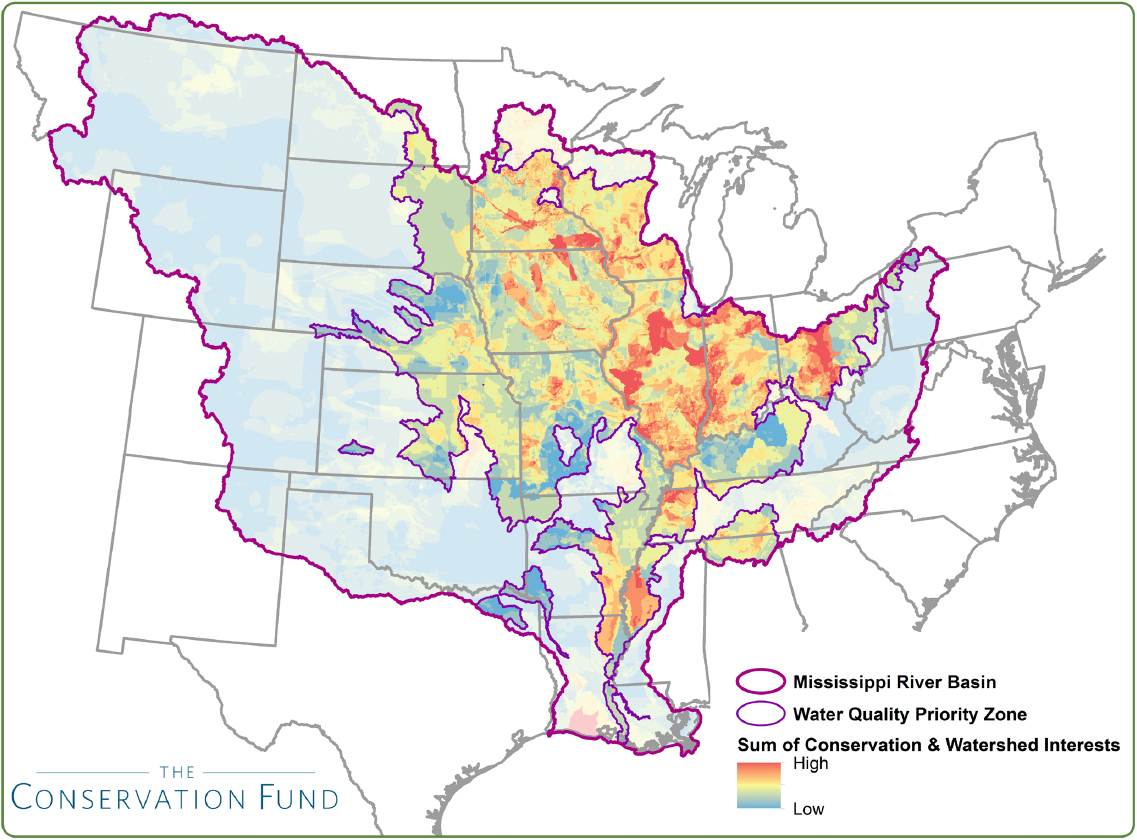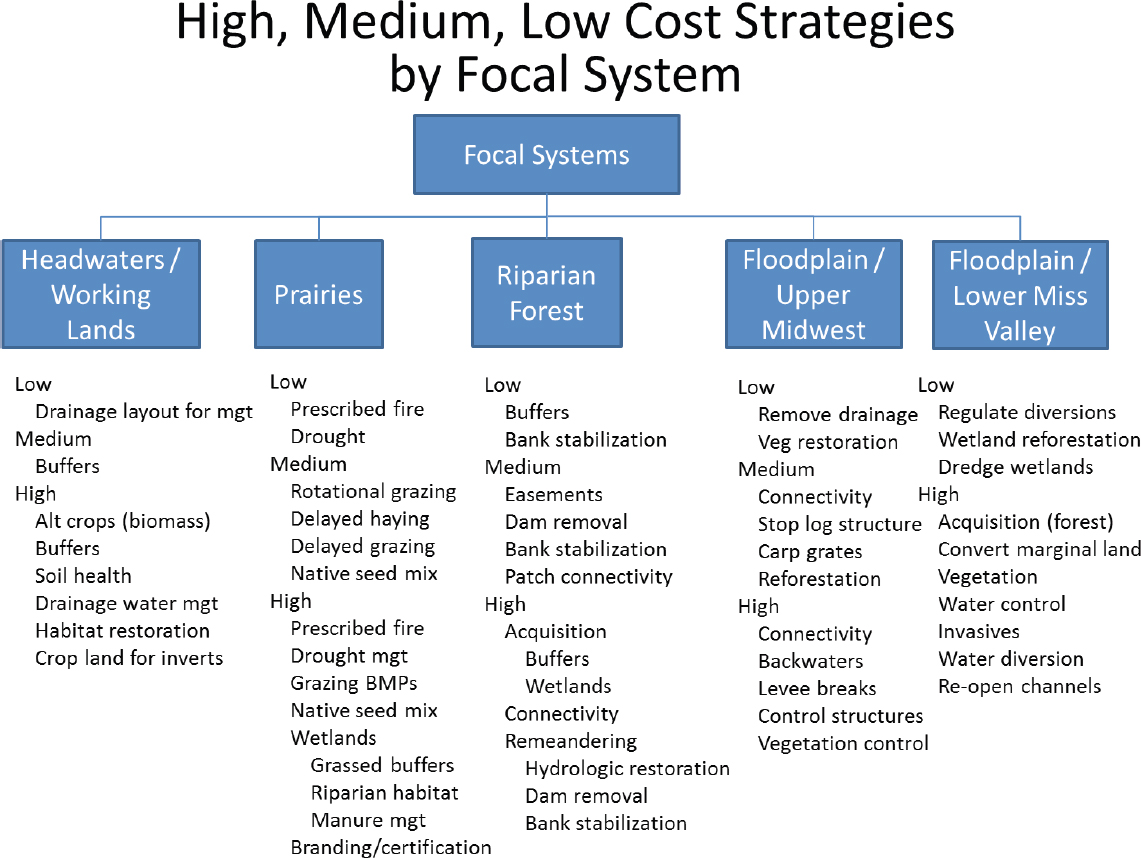Appendix B
Mississippi River Basin and Gulf Hypoxia: Collaborations Across Multiple LCCs
The Gulf hypoxia case study illustrates a response to addressing a conservation challenge that crosses Landscape Conservation Cooperative (LCC) boundaries, leading to collaboration among several LCCs, as in the sage-grouse study. It also illustrates an approach that is innovative, but challenging, in that it attempts to focus on an aspect of the problem not focused on by most of the current efforts and also that it adopts three fairly distinct conservation goals simultaneously (water quality, wildlife, and agriculture). A consortium of seven LCCs in the Mississippi River basin (Plains and Prairie Potholes, Upper Midwest and Great Lakes, Eastern Tallgrass Prairie and Big Rivers, Appalachian, Great Plains, Gulf Coast Prairie, and Gulf Coastal Plains and Ozarks) with funding from an LCC Network grant, developed the Mississippi River Basin/Gulf Hypoxia Initiative (MRB/GHI) (LCC Network, 2014).
The so-called Gulf dead zone, or region of hypoxia in the Gulf of Mexico off the mouth of the Mississippi River, has been a concern for some decades. Every summer, an area of between 2,000 and 8,000 square miles in which the level of dissolved oxygen falls below 2 parts per million forms off the Texas and Louisiana coasts (USGS, 2008). This low level of dissolved oxygen is known as hypoxia. This hypoxic zone leads to the death or outmigration of many aquatic organisms, including fish and shrimp, and has adverse ecological and economic consequences.
The formation of the zone is caused by nutrient-rich water coming out of the Mississippi River (NRC, 2012a). This nutrient-rich water promotes growth of plankton, which then dies, sinks out of the surface waters, and then decomposes, which reduces the oxygen. In addition, the freshwater from the river, being lighter than seawater, remains on the surface and causes stratification, which prevents new, oxygenated seawater from reaching the lower levels of the water column. The excess nutrients in the water derive mainly from agriculture in the Mississippi River basin.
Mitigating the Gulf hypoxia has been a goal for several programs at a variety of scales that are under way in the basin. The Mississippi River Gulf of Mexico Watershed Nutrient Task Force (MRGMWNTF), for example, was established in 1997 to “understand the causes and effects of eutrophication in the Gulf of Mexico; coordinate activities to reduce the size, severity, and duration; and ameliorate the effects of hypoxia.” The Task Force includes the U.S. Environmental Protection Agency, the U.S. Department of Agriculture (USDA), the U.S. Department of the Interior, the U.S. Army Corps of Engineers, and the National Oceanic and Atmospheric Administration. In addition, it includes state agency representation from Arkansas, Illinois, Indiana, Iowa, Kentucky, Louisiana, Minnesota, Mississippi, Missouri, Ohio, Tennessee, and Wisconsin; and from the National Tribal Water Council. It has produced an Action Plan (MRGMWNTF, 2008)1 and a reassessment (MRGMWNTF, 2013). The Action Plan “describes a national strategy to reduce, mitigate, and control hypoxia in the Northern Gulf of Mexico and improve water quality in the Mississippi River Basin.” The reassessment concludes that although actions taken by the Task Force’s members probably have helped to reduce the size of the hypoxic zone in recent years, environmental and economic conditions also have contributed. The National Research Council (NRC, 2012a) concludes that control efforts have not yet succeeded in reversing a long-term growth in the size of the hypoxic zone.
Another program is the Mississippi River Basin Initiative (MRBI), a “13-state initiative [that] builds on the cooperative work of NRCS and its conservation partners in the basin, and offers agricultural producers in priority watersheds the opportunity for voluntary technical and financial assistance.”2 The participating states are Arkansas, Illinois, Indiana, Iowa, Kentucky, Louisiana, Minnesota, Mississippi, Missouri, Ohio, South Dakota, Tennessee, and Wisconsin. This activity, also known as the Healthy
___________________
1 See http://water.epa.gov/type/watersheds/named/msbasin/hypoxia101.cfm.
2 See http://www.nrcs.usda.gov/wps/portal/nrcs/detail/oh/programs/landscape/?cid=stelprdb1119363.
Watersheds Initiative, was praised by the NRC in 2012 as having “attracted national-level attention and [holding] great potential. The USDA and its Natural Resources Conservation Service (NRCS) deserve recognition for its development and establishment.”
The NRC has issued several reports on the problem of water quality in the Mississippi River Basin and hypoxia in the Gulf. The most recent (NRC, 2012a) report recommended that numeric nutrient criteria be established for the northern Gulf of Mexico’s waters, saying that this would allow the U.S. Environmental Protection Agency and the Mississippi River states to work on developing allocations for nutrient loads throughout the basin. It also recommended establishing a basin-wide strategy for managing nutrients and water quality, adding
[a]lthough there have been some federal and state efforts to coordinate nutrient management and related water quality programs across the Mississippi River basin, interagency efforts to date have not produced a rigorous, action-oriented plan for reducing nutrient loadings. There is no comprehensive river-basin wide program that includes, for example, interim water quality goals to be achieved over a specified time horizon, nutrient load allocations across the basin’s tributary watersheds, a plan for more systematic data collection and analysis, or a framework of accountability to ensure achievement of goals and deadlines.
All the programs and effort described so far have focused entirely on water quality issues in the Gulf of Mexico. The effort reflected in the MRB/GHI aims to contribute through a slightly broader focus. As stated it is “intended to be complementary to related on-going efforts, like the Gulf of Mexico Hypoxia Task Force, Mississippi River Basin Initiative, and state nutrient reduction initiatives, but with an added emphasis on the ecological and social values of wildlife habitat” (emphasis in original). While still emphasizing water quality issues as central, this effort reflects a different, if not unique, perspective.
The area involved in the initiative is depicted in Figure B.1. The four fundamental objectives of the initiative are to increase fish and wildlife benefits, increase sustainable agricultural productivity, decrease Gulf hypoxia, and decrease implementation costs. The initiative focuses on four ecological systems, or focal habitats, and five agricultural production systems. The latter was done specifically in recognition that “practices will appeal differently to farmers producing a range of commodities.” This is an example of recognition that conservation programs must be tailored to the people who will be affected for them to be effective.
The consortium generated a set of high-, medium-, and low-cost strategies (see Figure B.2). The group is using structured decision making to create an integrated framework to assess the strategies and to create a Landscape Conservation Design. This activity is fairly new, and so the committee’s evaluation of the effort is focused on the approach rather than on the results to date.
The approach of this initiative has several positive features. As mentioned above, the recognition that ultimately conservation will be achieved by the work of people on the ground is a critical aspect of this initiative; this point also was made in a recent workshop on Mississippi River water quality and interstate collaboration, sponsored by the National Research Council (NRC, 2014a). Furthermore, the LCCs can contribute some research and monitoring components lacking in the MRBI. Another feature is the use of structured decision making to develop and prioritize strategies, taking costs into account. One is the recognition of ecological and wildlife values in addition to a more traditional focus on agricultural practices. Similarly, ecological restoration and conservation will need to be balanced with preservation of archeological sites and cultural values and preferences with regard to natural resource extraction. Obviously, the formation of a consortium of seven LCCs reflects an organic, adaptive flexibility in the LCC Network that seems likely to be effective and can assess the range of trade-offs.
For a summative evaluation in the future, it will be important to gather information and metrics that will enable one to answer questions such as the following: How well will the structured decision making translate into conservation gains and how well will different values be incorporated into the process? How well will the three disparate objectives (wildlife, water quality, and agriculture) be integrated and to what degree might they hinder progress or at least complicate evaluation of the initiative? Finally, how well will the MRB/GHI actually collaborate or at least coordinate with the several other Gulf hypoxia initiatives and activities currently under way?

SOURCES: Eastern Tallgrass Prairie and Big Rivers LCC; the Conservation Fund.

NOTE: alt = alternative; inverts = invertebrates; BMP = best management practice; mgt = management; veg = vegetation.




